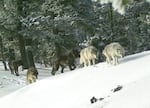Oregon State Police are seeking the public’s help, now that their investigation into the poisoning of eight wolves in Eastern Oregon has stalled out.
State troopers with the agency’s Fish and Wildlife Division have been trying since last February to determine who is responsible for the poisoning deaths of all five wolves in the Catherine Pack. The dead wolves were located southeast of Mount Harris in Union County, according to an OSP press release issued Thursday.

A pack of wolves makes their way through the snow in Northeastern Oregon.
Courtesy of the Oregon Department of Fish and Wildlife
Over the following months, police expanded their investigation to include three more wolves that were found dead. Toxicology reports indicated they, too, had been poisoned. One was a female that had dispersed from the Keating Pack, another was a female from the Clark Creek Pack northeast of La Grande and the third was a male from the Five Points Pack west of Elgin.
Conservation groups, after learning about law enforcement’s request for public help solving the case, have stepped up to reward cash — $26,000 from Oregon groups and $10,000 from Rocky Mountain region wildlife organizations — for anyone who provides information leading to the arrest and prosecution of a poacher responsible for the wolf poisonings.
Police also found two magpies and a skunk near the spot where the dead wolves were located. Toxicology reports found they also had poison in their systems.
The fatal poisonings surfaced amidst growing tension between ranchers and their supporters, and the wildlife advocates that support the return of these predators across the West. Since July 1, the state has confirmed that wolves killed 29 cows, 19 sheep, nine goats and one dog in Oregon.
Amaroq Weiss, senior wolf advocate with the Center for Biological Diversity, said on OPB’s “Think Out Loud” Thursday that those numbers represent a tiny fraction of the number of livestock that die every year. She said Oregon overall has 1.4 million cattle, calves, sheep and lambs and 178 wolves.
“One one-thousandth of Oregon’s livestock are lost each years to wolves,” she said. “It’s a very small percentage.”
Weiss also said there is not a body of science that shows killing wolves can solve conflicts, and that it can actually make conflicts worse. For example, she said, when the breeding male wolf in a pack and the subadults in a pack were killed last summer because they had preyed on livestock, that left a lone female wolf to raise the surviving pups. That, Weiss said, increased the likelihood that the wolf would kill a calf rather than a deer or elk because it is responsible for both rearing young and leaving to find food.
“There’s a lot more losses than just the confirmed livestock,” John Williams, incoming wolf committee chair for Oregon Cattlemen’s Association, said Thursday on “Think Out Loud.” He said the ranches that are missing livestock are missing, on average, 10% of their calves, based on preliminary estimates. Williams said there’s a strong probability that wolves are responsible.
He said the toll can be measured not just in dead or missing livestock. Once a herd is attacked, surviving cows are “stressed out” and aware of the continued presence of wolves. That leads to lower weights and reduced birthrates, Williams said.
Livestock depredations have prompted the state to sanction the killing (it uses the term “lethal removal”) of eight wolves in the Lookout Mt. Pack this year after determining they were responsible for “chronic livestock depredation despite non-lethal measures,” according to Oregon Department of Fish and Wildlife spokesperson Michelle Dennehy.
Before 2021, 16 wolves were killed by ODFW or authorized agents in response to chronic depredations of livestock.
Related: The fate of Oregon’s gray wolves is now in the state’s hands
The state operates a compensation program for ranchers’ livestock losses that result from confirmed or probable wolf predation. The program also provides grants for counties to help pay for supplies and implement preventative measures. In 2020 it awarded funds totaling $251,529.
Wolves have historically been an important and widespread part of ecosystems across North America. That changed after a campaign began in the 19th century to drive the predators toward extinction to make way for cattle and sheep grazing in Oregon and other Western states.
The Trump administration gave the anti-wolf movement a boost when it removed Endangered Species Act protections for gray wolves — a move that is now under legal challenge.
Oregon State Police said their wolf-poisoning investigation was initially hampered because of snow and bad weather. They are turning to the public for help because all their leads have been exhausted, according to Thursday’s press release.
Police are asking anyone with information related to the investigation to call 1-800-452-7888 or email TIP@state.or.us.
Correction: Dec. 2, 2021. An earlier version of this story misstated the percentage of missing livestock in Oregon. For the ranches that are missing livestock, they are missing, on average, 10% of their calves, based on preliminary estimates, according to John Williams, incoming wolf committee chair for Oregon Cattlemen’s Association.
